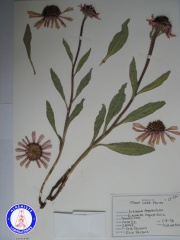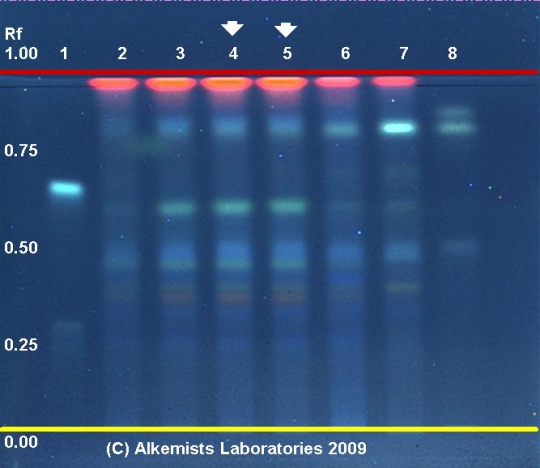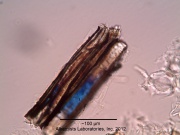Introduction
Macroscopic Entries
| The root is described as nearly entire, cylindrical,
very slightly tapering and sometimes slightly spirally twisted, from 10 to 20 cm. in length and from 4 to 13 mm. in diameter, externally grayish-brown, light brown or purplish-brown, slightly annulate in the upper portion, with occasional V-shaped stem scars, somewhat longitudinally wrinkled, or furrowed; fracture short, fibrous, bark less than 1 mm. in thickness, wood thick and composed of alternate light yellowish and black wedges; the rhizome with a circular pith. Odor faint, aromatic; taste sweetish, followed by a tingling sensation suggesting aconite, but lacking the persistent and benumbing effect produced by that drug.
Source: United States Dispensatory (1918) [1]
|
|
|
|
| Echinacea angustifolia Botanical Voucher Specimen (1/2)- Alkemists Laboratories
Source: Botanical Voucher Specimen Library, Alkemists Laboratories [2]
|
|

Echinacea angustifolia Botanical Voucher Specimen (1/2)- Alkemists Laboratories
|
|
Microscopic Entries
| Under the
microscope, sections show the presence of intercellular (schizogenous) oil and resin cavities or reservoirs in both the wood and bark, numerous stone cells distinguished by the presence of a blackish, resinous substance in the intercellular spaces between them and some of the adjoining parenchyma, the latter containing masses or aggregates of inulin. The walls of the tracheae or vessels are marked with simple slitlike pores or annular and reticulate thickenings; bast fibers occur in the stem, and in some specimens true libriform or wood fibers are found.
Source: United States Dispensatory (1918) [3]
|
|
|
|
| Fibers showing black phtymelanin of Echinacea angustifolia root viewed under 400x with Acidified Chloral Hydrate Solution.
Source: Elan M. Sudberg, Alkemist Laboratories [4]
|
|
|
|
HPTLC Entries

Echinacea angustifolia HPTLC ID - Natural Product Reagent + PEG UV 365 nm
Narrow-leaf Echinacea (root) (Echinacea angustifolia)
Lane Assignments Lanes, from left to right (Track, Volume, Sample):
- 3 μL Echinacoside, Cynarin ~0.1% in Methanol
- 3 μL Echinacea angustifolia-1 (herb)
- 3 μL Echinacea angustifolia-2 (herb)
- 3 μL Echinacea angustifolia-3 (herb)
- 3 μL Echinacea angustifolia-3 (herb)
- 3 μL Echinacea angustifolia-4 (herb)
- 3 μL Echinacea angustifolia-5 (herb)
- 3 μL Caftaric Acid, Cichoric Acid ~0.1% in Methanol
Reference materials used here have been authenticated by macroscopic, microscopic &/or TLC studies according to the reference source cited below held at Alkemists Laboratories, Costa Mesa, CA.
Stationary Phase Silica gel 60, F254, 10 x 10 cm HPTLC plates
Mobile Phase ethyl acetate: MEK methylethyl ketone: HCOOH: H2O [5/3/1/1]
Sample Preparation Method 0.3 g + 3 ml CH3OH sonicate 10 min NO HEAT
Detection Method Natural Product Reagent + PEG -> UV 365 nm
Reference see American Herbal Pharmacopoeia & Therapeutic Compendium
Source: Elan M. Sudberg, Alkemist Laboratories [5]
|
Other Points of Interest
Cite error: <ref> tags exist, but no <references/> tag was found




